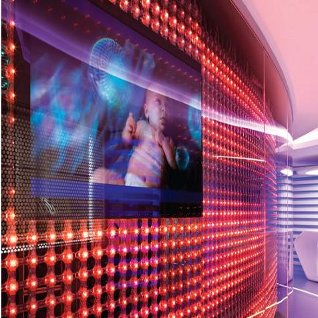IBM Software Executive Briefing Centre, Rome
Curving lines, shining surfaces and a sleek Italian sensibility combine to dazzle at IBM’s newly renovated client training facility, but homely touches ensure that spectacle is tempered with comfort
Details
Client: IBM Software
Design: losa Ghini Associati
Size: 1,500 sq m
Completion time: 12 months
Photography: Santi Caleca
Project Details
A software executive briefing centre may sound like the kind of sterile office environment in which many of us spend far too much of our time. But in the case of IBM’s newly renovated training facility in Rome, at least, this could not be further from the truth, thanks to an ultra-modern design scheme by Italian architect Massimo Iosa Ghini.
Housed within a kind of IBM campus, which also contains a software development lab, the software executive briefing centre (the EBC for short) is a place where IBM’s major clients go to learn about the latest software and how they can use it to meet their clients’ needs.
Typically, clients will attend whole days of presentations and demonstrations, and this means the EBC has to be both flexible and comfortable in its design, says Iosa Ghini. ‘The EBCs are very sophisticated structures, which provide specialised training in various topics,’ he says. ‘So as well as creating flexibility to accommodate small and large groups of people, we also had to incorporate advanced audiovisual technology as well as providing comfortable places for visitors to relax between presentations, including a cafeteria and bar.’
The centre’s manager, Peter Dardarananda, worked closely with Iosa Ghini on the project, briefing him to design a space that would ‘not only meet but exceed a client’s expectation of what IBM represents’.
IBM already has EBCs in the USA and the UK, some of which Iosa Ghini and his team visited in preparation for this project. But Dardarananda wanted to avoid what he calls a ‘cookie-cutter’ approach to design: while the functional specifications, including presentation spaces, videoconferencing and audiovisual technology, may be broadly the same, Dardarananda wanted this EBC to be unique, with its design reflecting the global IBM brand through a very Italian design language.
The scheme takes its cue from modern communications technology, with curving glass walls and ceilings enclosing grids of coloured LED lighting and LCD screens, which are reflected in surfaces of polished glass, resin and white Corian. Most of the light fittings are hidden from view and much of the space is lit indirectly: strips of LED lighting are embedded in grooves in the ceiling, and a single strip of white light recessed in a resin floor guides visitors along a curving corridor.
Inspired by IBM’s distinctive eight-striped logo, designed by graphic designer Paul Rand in 1972 (Rand originally designed a solid logo in 1956), Iosa Ghini has used a similar striped motif in the EBC, including a striped graphic on the glass walls of a conference room.
Overall, the look is clean, modern and hightech, but Iosa Ghini has balanced this with more natural touches, including a green wall (a wall of living plants) in the main corridor. He has also used a range of flooring treatments relative to the function of each area. Flooring in the reception and corridors, for example, is white resin, while the canteen has a warmer, more homely feel with wooden parquet floors. A quiet room has a moquette floor, which was chosen for comfort and to improve acoustics.
Key furniture pieces are bespoke, including a reception desk made of white Corian, and armchairs custom-made by Italian furniture company Moroso, which were jointly designed by Iosa Ghini and Dardarananda. Non-bespoke furniture includes seating and meeting tables by Haworth.
For Iosa Ghini, this project is the realisation of 25 years’ experience in the design industry and he feels it pushes the boundaries in terms of the ‘possibilities that creativity applied to design can provide’. Dardarananda agrees: ‘Projects like this that have unusual characteristics concerning integration of technology, corporate style, functionality, and engineering challenges, are not easy but we achieved the dream because [Iosa Ghini] and I had a perfect and complementary relationship that allowed us to share a vision and to ultimately transform it into a reality.’
He adds: ‘We have received praise and compliments from many who have had the opportunity to visit the EBC and I truly smile when people say “wow!”, which is exactly the jaw-dropping effect we wanted.’
This article was first published in fx Magazine.












